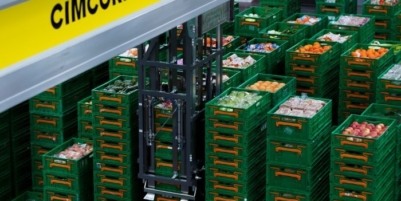-
ROSSLARE EUROPORT TARGETS HEALTH & SAFETY WITH CAMERA TELEMATICS PARTNERSHIP - 2 days ago
-
Landmark Study Reveals Wearable Robotics Significantly Boost Safety and Efficiency in Industrial Environments - July 24, 2024
-
Visku Tackle The Retail Seasonality Challenge One Pallet At A Time - July 22, 2024
-
KAMMAC AND BERGEN LOGISTICS STRENGTHEN FASHION & LIFESTYLE SERVICES IN THE UK - July 19, 2024
-
TENTBOX EXTENDS PARTNERSHIP WITH ARROWXL TO SUPPORT INCREASING DEMAND - July 17, 2024
-
The Perfume Shop improves customer journeys while driving profitability in partnership with Scurri - July 17, 2024
-
ZEROMISSION SECURES £2.3M ($3M) INVESTMENT TO ACCELERATE ELECTRIC FLEETS - July 16, 2024
-
BCMPA CELEBRATES SUCCESS OF 2024 CONFERENCE - July 15, 2024
-
Best of the Best: Jungheinrich Celebrates Triple International Award Win - July 12, 2024
-
GOPLASTICPALLETS.COM CALLS ON NEW CHANCELLOR RACHEL REEVES TO CONSIDER PLASTIC PACKAGING TAX REFORM - July 10, 2024
Caster Concepts launches product initiative to help manufacturers manage staffing shortages by moving more with less
With more manufacturing jobs than there are people to fill them and the demand for products increasing, Caster Concepts Inc.(casterconcepts.com) announces a product design initiative to help manufacturers cope with labor shortages and move more materials with smaller teams of employees.
Caster Concepts engineers have released a variety of casters that improve the use of manual dollies, especially those used to transport heavy EV batteries at automotive plants. These ergonomically designed casters like the new TWERGO XTREME, allow manufacturers to keep pace with demand and improve efficiency.
The company has also unveiled casters (95 HD, 97 HD, and Swivel on Swivel) specifically designed to enhance the use of automated guided vehicles (AGV) popular with aerospace, automotive, agriculture and heavy-industry manufacturers. With a high-capacity swivel section, these casters reduce the turning force, making it easier for AGVs to maneuver. Enhanced maneuverability results in less strain on AGV batteries, which reduces overall maintenance costs.
“We recognize the workforce challenges on the industry and to a certain extent we feel it in our own business,” said Caster Concepts President Bill Dobbins. “By rethinking how products are designed and employing the latest technology to develop material handling systems, we’re helping manufacturers work more efficiently.”
Product overview
- TWERGO® and TWERGO® XTREME allow smaller manufacturing teams to move loads up to 3000 pounds while staying below the 50-pound start push force safety limits established by OSHA. Xtreme improves the efficiency of EV dollies by reducing the push force to 44 pounds and allows operators to move more batteries per dolly. Manufacturers can save upwards of $4 million by reducing their fleet of dollies and simply using TWERGO and TWERGO XTREME.
- The Drive Caster is a motorized caster system designed to move heavy loads with fewer people. The strain previously required to move thousands of pounds can be replaced with the push of a button. An easily customizable control box allows for a number of power and control options.
- The Swivel on Swivel Caster is specifically designed to save AGV battery life and reduce motor torque. It also allows for more precise movements with little vehicle sway. By decreasing resistance when turning and moving, AGVs can move heavier loads without the need for a larger drive system. (More AGV casters)
- 95 HD, 97 & 97 HD Series: With a high-capacity swivel section, the caster reduces force load, making it easier to move and maneuver. Automation is definitely a major part of modern production processes by improving productivity, among other benefits. The 95 and 97 HD casters easily maneuver around tight corners, reduce the drain on motor-powered platforms, and carry between 10,000 and 20,000 pounds per caster, respectively. They’re the newest muscle in motor-powered material handling.
The workforce challenges felt in the manufacturing industry stem from the impact of the COVID-19 pandemic. Millions of furloughed workers didn’t return to their jobs once plants reopened. Many left the industry entirely, stalling production and forcing manufacturers to hire inexperienced workers.
The National Association of Manufacturers foresees that “2.1 million manufacturing jobs could go unfilled by 2030.” These vacancies could cost the industry upwards of $1 trillion.
“Years ago, we focused on designing products to meet the highest ergonomic standards in the industry,” Dobbins said. “That move improved manufacturing efficiency and reduced injuries. Now we’re taking our engineering efforts further, employing technology so companies can continue to produce at a high level with smaller teams of employees. Our industry demands the change, and we’re staying in tune with its needs.”

































